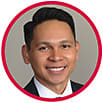
You’re fully booked, and then that 11 a.m. patient doesn’t arrive for their appointment. The average patient no-show rate for U.S. optometric practices is about 25%, according to Solutionreach.
Overall, no-shows cost the U.S. health care system more than $150 billion a year. As for days and times, BMC Health Services Research finds that seniors are the most likely patients to miss appointments, and that Mondays are the worst for this. What about time of year? According to BMC, practices report the highest number of missed appointments in September.
To find out how your peers are managing this madness in their corporate optometric practices, we asked three ODs to share their experiences and explain how they address this costly issue.

National Vision preceptor Ian Ymalay, OD, says now that the post-COVID-19 pandemic backlog of patients needing eye care has been met, business “has settled back to the normal pace, and my office has an average no-show rate of between 15% and 20%.”

MULTIPLE REMINDERS
Dr. Ymalay, who operates an America’s Best location, in Algonquin, Ill., agrees that the best way to minimize missed appointments is by reaching out to patients at multiple points of contact.
“One thing that has helped reduce no-shows is sending appointment reminders and confirmation requests through email, text, and phone,” he explains. “This ensures we’re reaching patients via their preferred method of contact in the week leading up to their exam. If they do have a conflict, it allows them to reschedule and us to open that slot back up for a different patient.”
MANAGING NO-SHOWS

Though some practices charge a $25 no-show fee, none of the ODs we interviewed charge one…yet. Camille Cohen, OD, who opened her Pearle Vision franchise in Brooklyn, NY, just before COVID-19 struck, says she’s considering adding one and formalizing her no-show policy.
She has, however, already reduced missed appointments by changing her hours. “The number of Saturday no-shows increased during COVID, so, I cut Saturday from the schedule. It’s the best decision I’ve ever made for myself and my staff. Since eliminating weekend hours, our weekday no-show rate has dramatically decreased!”
What about firing patients? “I personally don’t believe in firing patients because of their no-show history,” says Dr. Ymalay. “I would, perhaps, take a walk-in during their time slot just in case they don’t show. If the patient does present for their appointment, it doesn’t throw off my day because our offices are staffed with well-trained associates.”
All agree it’s important to analyze and track the percentage of no-shows in a practice. It may be a cost of doing business, but it’s one that can be managed. And minimized. OM



